动词不定式做状语时表示目的和结果的用法
高考英语非谓语动词作状语的用法 知识点
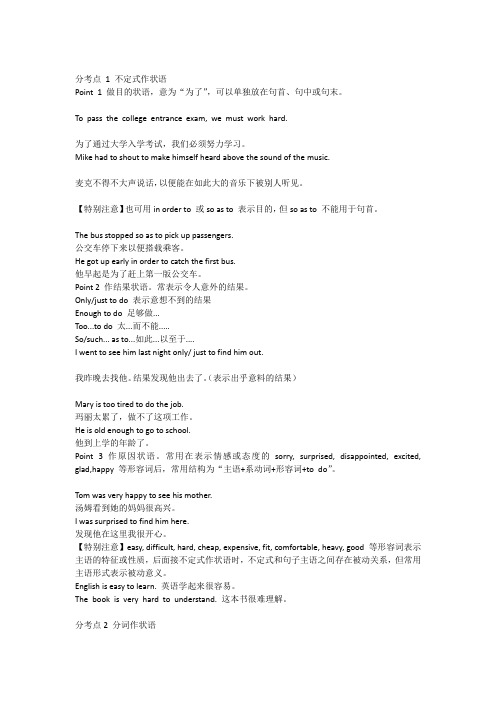
分考点1 不定式作状语Point 1 做目的状语,意为“为了”,可以单独放在句首、句中或句末。
To pass the college entrance exam, we must work hard.为了通过大学入学考试,我们必须努力学习。
Mike had to shout to make himself heard above the sound of the music.麦克不得不大声说话,以便能在如此大的音乐下被别人听见。
【特别注意】也可用in order to 或so as to 表示目的,但so as to 不能用于句首。
The bus stopped so as to pick up passengers.公交车停下来以便搭载乘客。
He got up early in order to catch the first bus.他早起是为了赶上第一版公交车。
Point 2 作结果状语。
常表示令人意外的结果。
Only/just to do 表示意想不到的结果Enough to do 足够做...Too...to do 太...而不能.....So/such... as to...如此...以至于....I went to see him last night only/ just to find him out.我昨晚去找他。
结果发现他出去了。
(表示出乎意料的结果)Mary is too tired to do the job.玛丽太累了,做不了这项工作。
He is old enough to go to school.他到上学的年龄了。
Point 3 作原因状语。
常用在表示情感或态度的sorry, surprised, disappointed, excited, glad,happy 等形容词后,常用结构为“主语+系动词+形容词+to do”。
Tom was very happy to see his mother.汤姆看到她的妈妈很高兴。
to do作状语
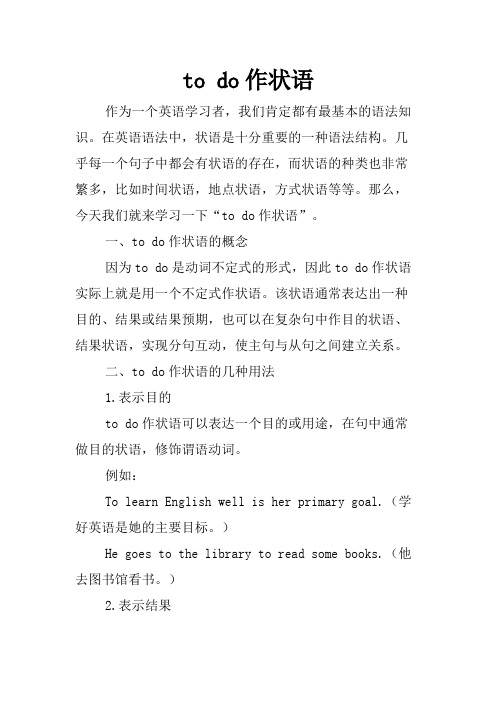
to do作状语作为一个英语学习者,我们肯定都有最基本的语法知识。
在英语语法中,状语是十分重要的一种语法结构。
几乎每一个句子中都会有状语的存在,而状语的种类也非常繁多,比如时间状语,地点状语,方式状语等等。
那么,今天我们就来学习一下“to do作状语”。
一、to do作状语的概念因为to do是动词不定式的形式,因此to do作状语实际上就是用一个不定式作状语。
该状语通常表达出一种目的、结果或结果预期,也可以在复杂句中作目的状语、结果状语,实现分句互动,使主句与从句之间建立关系。
二、to do作状语的几种用法1.表示目的to do作状语可以表达一个目的或用途,在句中通常做目的状语,修饰谓语动词。
例如:To learn English well is her primary goal.(学好英语是她的主要目标。
)He goes to the library to read some books.(他去图书馆看书。
)2.表示结果to do作状语还可以表示一种结果或结果预期,这种情况下通常可以用so as to do和in order to do两种形式代替。
例如:She runs for an hour every day to keep fit.(她每天跑一个小时以保持身材。
)I eat a lot of vegetables to keep healthy.(我吃很多蔬菜以保持健康。
)3.时间状语to do作为时间状语的情况比较少,通常表达时间的判断,而句子中一般不存在谓语。
常常用于描述固定时间。
例如:1. We have got three hours to wait.2. He has two weeks to prepare for the exam.三、to do作状语的注意事项1.在to do前面不需要加上介词“for”或“in”。
2.to do作状语是需要固定搭配的,不能随意插入或更改顺序,否则就可能造成语法连贯性的问题。
非谓语动词作状语的用法

非谓语动词作状语的用法介绍非谓语动词是指不具有人称和数的动词形式,例如动词的不定式、动名词和现在分词。
它们在句子中常常用作状语,用来修饰或者补充说明动作或状态的情况。
本文将介绍非谓语动词作状语的用法。
不定式作状语不定式作状语常使用 to + 动词原形的形式,可以表示目的、结果、原因、方式等。
例如:- 目的:He went to the store to buy some groceries.- 结果:She ran fast to catch the bus.- 原因:I walked slowly to avoid slipping on the icy road.- 方式:He spoke softly to not disturb the sleeping baby.动名词作状语动名词作状语常使用动词 + -ing 的形式,可以表示原因、方式、条件、时间等。
例如:- 原因:She failed the test by not studying enough.- 方式:They solved the problem by working together.- 条件:You can improve your English by practicing regularly.- 时间:She finished the project by staying up all night.现在分词作状语现在分词作状语常使用动词 + -ing 的形式,可以表示原因、时间、条件等。
例如:- 原因:Feeling hungry, he decided to go out for dinner.- 时间:Waiting for the train, she listened to music.- 条件:Being late, he missed the beginning of the movie.注意事项1. 非谓语动词作状语时,要注意逻辑关系和修饰对象的一致性。
语法不定式做状语

4. 不定式还可以作结果状语或原因状语: 结果状语:
1. He was so late as to miss half of the lecture.
2. She is such a good student as to be
respected by all her classmates.
3. The house is large enough to hold 2000
so + many / few +名词复数 + that
1) She has so few friends that she often feels lonely.
2) There were so many people at the station that I didn’t recognize her.
1.He hurried to his house, only to find it had been broken into.
2.Her parents died, leaving her an orphan.
3.There was a tornado yesterday, causing 100 deaths.
early in the morning .
5.不定式有时需要用被动形式、完成形式 或进行时。
1.She was sent to England so as to be educated.
2.She left home, never to be seen again. 3.He was shamed to be seen doing this
Module Two
Grammar
——动词 to 不定式作状语
动词不定式作结果状语:

动词不定式作结果状语:动词不定式作结果状语动词不定式是一种常见的短语结构,在句子中可以充当结果状语。
动词不定式作为结果状语时,说明主要动词的结果或目的。
本文将介绍动词不定式作为结果状语的用法和例句。
1.动词不定式作结果状语的位置和形式动词不定式作为结果状语通常位于句子中的谓语动词之后,修饰整个句子或主语。
它的形式是“to + 动词原形”,也可以用动词不定式的完成式形式(“to have + 过去分词”)。
2.动词不定式作结果状语的用法动词不定式作为结果状语可以表达以下几种意义:目的:表示主要动作的目的或预期结果。
结果:表示主要动作的效果或将要发生的结果。
原因:表示主要动作的原因或理由。
3.动词不定式作结果状语的例句下面是一些动词不定式作为结果状语的例句:To learn a new language is my goal.(研究一门新语言是我的目标。
)I went to the library to ___.(我去图书馆借书。
)She works hard to improve her English.(她努力工作以改善她的英语。
)He ran fast to catch the bus.(他跑得很快以赶上公交车。
)They studied hard to pass the exam.(他们努力研究以通过考试。
)She saved money to buy a new car.(她节省钱来买一辆新车。
)4.总结动词不定式作为结果状语可以帮助我们描述主要动作的目的、结果或原因。
它位于谓语动词之后,修饰整个句子或主语。
在使用时,我们需要注意动词不定式的形式和语境。
非谓语动词在句子中作状语和作宾语补足语的不同用法
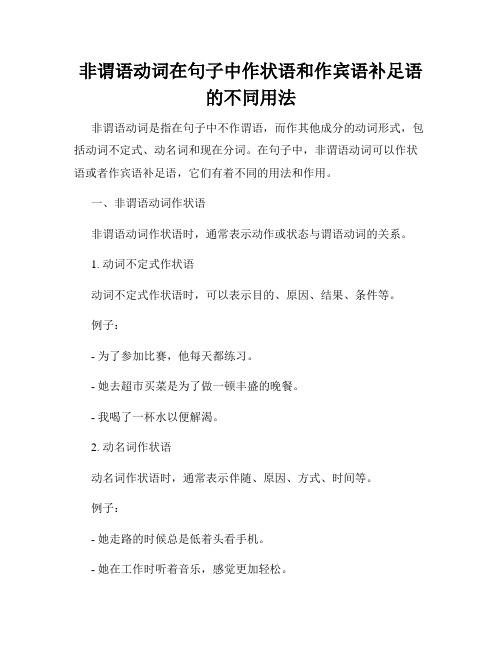
非谓语动词在句子中作状语和作宾语补足语的不同用法非谓语动词是指在句子中不作谓语,而作其他成分的动词形式,包括动词不定式、动名词和现在分词。
在句子中,非谓语动词可以作状语或者作宾语补足语,它们有着不同的用法和作用。
一、非谓语动词作状语非谓语动词作状语时,通常表示动作或状态与谓语动词的关系。
1. 动词不定式作状语动词不定式作状语时,可以表示目的、原因、结果、条件等。
例子:- 为了参加比赛,他每天都练习。
- 她去超市买菜是为了做一顿丰盛的晚餐。
- 我喝了一杯水以便解渴。
2. 动名词作状语动名词作状语时,通常表示伴随、原因、方式、时间等。
例子:- 她走路的时候总是低着头看手机。
- 她在工作时听着音乐,感觉更加轻松。
- 他生气时喜欢一个人静静地待在房间里。
3. 现在分词作状语现在分词作状语时,通常表示时间、原因、结果、条件等。
例子:- 孩子们坐在河边嬉戏的时候,天空中飞过一只小鸟。
- 雨停了,她放下伞继续前行。
- 他跑得太快,以至于摔倒在地。
二、非谓语动词作宾语补足语非谓语动词作宾语补足语时,通常与及物动词或介词搭配使用,用来修饰宾语。
1. 动词不定式作宾语补足语动词不定式作宾语补足语时,通常表示动作的结果或目的。
例子:- 她希望能赚到更多的钱。
- 他们需要找到一个解决问题的方法。
- 我喜欢把房间布置得温馨舒适。
2. 动名词作宾语补足语动名词作宾语补足语时,通常表示动作的结果、原因、方式等。
例子:- 他喜欢听别人讲故事。
- 她害怕看到血液。
- 我对你的成功感到骄傲。
3. 现在分词作宾语补足语现在分词作宾语补足语时,通常表示动作的结果、方式等。
例子:- 孩子们使整个教室变得非常吵闹。
- 她发现这个问题变得越来越困难。
- 他的话让她感到非常惊讶。
总结起来,非谓语动词在句子中作状语时表示动作与谓语的关系,可以使用动词不定式、动名词和现在分词。
非谓语动词作宾语补足语时则用来修饰宾语,常见的形式有动词不定式、动名词和现在分词。
动词不定式作状语的用法
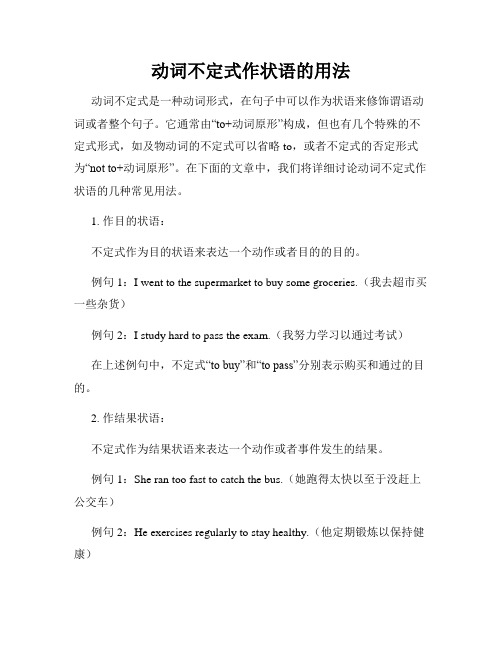
动词不定式作状语的用法动词不定式是一种动词形式,在句子中可以作为状语来修饰谓语动词或者整个句子。
它通常由“to+动词原形”构成,但也有几个特殊的不定式形式,如及物动词的不定式可以省略to,或者不定式的否定形式为“not to+动词原形”。
在下面的文章中,我们将详细讨论动词不定式作状语的几种常见用法。
1. 作目的状语:不定式作为目的状语来表达一个动作或者目的的目的。
例句1:I went to the supermarket to buy some groceries.(我去超市买一些杂货)例句2:I study hard to pass the exam.(我努力学习以通过考试)在上述例句中,不定式“to buy”和“to pass”分别表示购买和通过的目的。
2. 作结果状语:不定式作为结果状语来表达一个动作或者事件发生的结果。
例句1:She ran too fast to catch the bus.(她跑得太快以至于没赶上公交车)例句2:He exercises regularly to stay healthy.(他定期锻炼以保持健康)在上述例句中,不定式“to catch”和“to stay”分别表示未能赶上和保持健康的结果。
3. 作方式状语:不定式作为方式状语来描述一个动作或者事件的方式。
例句1:He spoke in a soft voice to not disturb others.(他小声说话以免打扰其他人)例句2:They walked slowly to enjoy the beautiful scenery.(他们慢慢地走以欣赏美景)在上述例句中,不定式“to not disturb”和“to enjoy”分别表示不打扰和欣赏的方式。
4. 作条件状语:不定式作为条件状语来描述一个条件或者前提。
例句1:In order to pass the test, you need to study hard.(为了通过考试,你需要努力学习)例句2:To be successful, you have to work hard.(要成功,你必须努力工作)在上述例句中,不定式“to pass”和“to be successful”分别表示通过和成功的条件。
常见动词不定式词组、句型用法总结
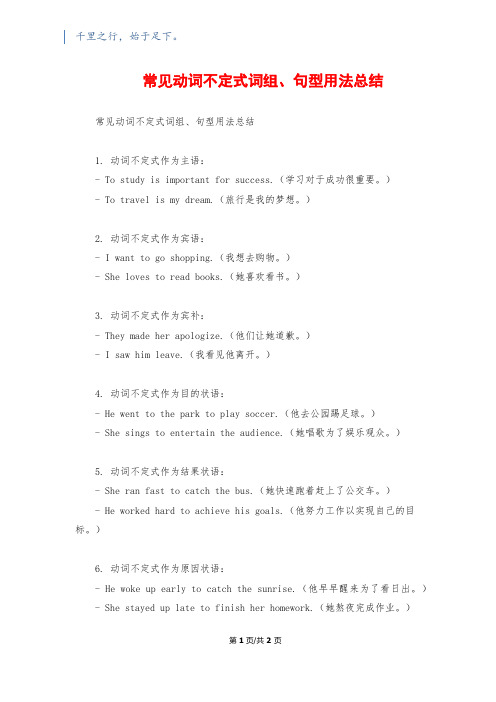
千里之行,始于足下。
常见动词不定式词组、句型用法总结常见动词不定式词组、句型用法总结1. 动词不定式作为主语:- To study is important for success.(学习对于成功很重要。
)- To travel is my dream.(旅行是我的梦想。
)2. 动词不定式作为宾语:- I want to go shopping.(我想去购物。
)- She loves to read books.(她喜欢看书。
)3. 动词不定式作为宾补:- They made her apologize.(他们让她道歉。
)- I saw him leave.(我看见他离开。
)4. 动词不定式作为目的状语:- He went to the park to play soccer.(他去公园踢足球。
)- She sings to entertain the audience.(她唱歌为了娱乐观众。
)5. 动词不定式作为结果状语:- She ran fast to catch the bus.(她快速跑着赶上了公交车。
)- He worked hard to achieve his goals.(他努力工作以实现自己的目标。
)6. 动词不定式作为原因状语:- He woke up early to catch the sunrise.(他早早醒来为了看日出。
)- She stayed up late to finish her homework.(她熬夜完成作业。
)第1页/共2页锲而不舍,金石可镂。
7. 动词不定式作为条件状语:- If you want to succeed, you must work hard.(如果你想成功,你必须努力。
)- You have to practice every day to improve your English.(你必须每天练习才能提高英语。
)8. 动词不定式作为伴随状语:- She listened to music to relax.(她听音乐放松。
不定式作定语与状语的用法解析
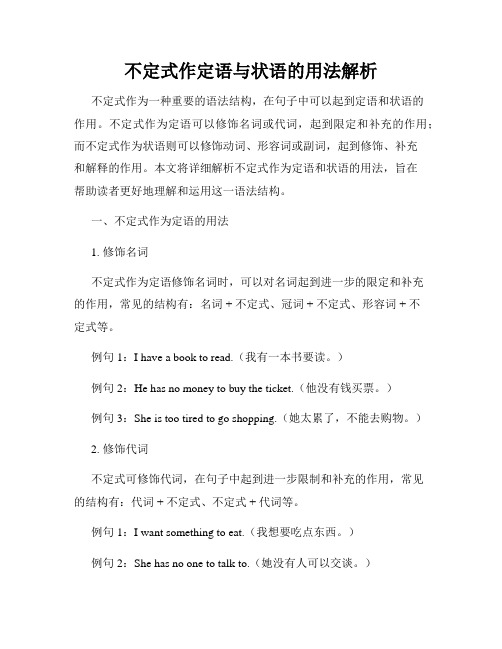
不定式作定语与状语的用法解析不定式作为一种重要的语法结构,在句子中可以起到定语和状语的作用。
不定式作为定语可以修饰名词或代词,起到限定和补充的作用;而不定式作为状语则可以修饰动词、形容词或副词,起到修饰、补充和解释的作用。
本文将详细解析不定式作为定语和状语的用法,旨在帮助读者更好地理解和运用这一语法结构。
一、不定式作为定语的用法1. 修饰名词不定式作为定语修饰名词时,可以对名词起到进一步的限定和补充的作用,常见的结构有:名词 + 不定式、冠词 + 不定式、形容词 + 不定式等。
例句1:I have a book to read.(我有一本书要读。
)例句2:He has no money to buy the ticket.(他没有钱买票。
)例句3:She is too tired to go shopping.(她太累了,不能去购物。
)2. 修饰代词不定式可修饰代词,在句子中起到进一步限制和补充的作用,常见的结构有:代词 + 不定式、不定式 + 代词等。
例句1:I want something to eat.(我想要吃点东西。
)例句2:She has no one to talk to.(她没有人可以交谈。
)例句3:He needs you to help him.(他需要你帮助他。
)二、不定式作为状语的用法1. 修饰动词不定式作为状语修饰动词时,可以表示目的、原因、结果等,常见的结构有:动词 + 不定式、不定式 + 动词等。
例句1:He went to the supermarket to buy some groceries.(他去超市买了些食品杂货。
)例句2:She ran fast to catch the bus.(她快速跑去赶公交车。
)例句3:They study hard to pass the exam.(他们努力学习以通过考试。
)2. 修饰形容词和副词不定式作为状语修饰形容词和副词时,可以表示程度、方式、目的等,常见的结构有:形容词/副词 + 不定式、不定式 + 形容词/副词等。
高中英语语法讲义:不定式作定语和状语用法归纳
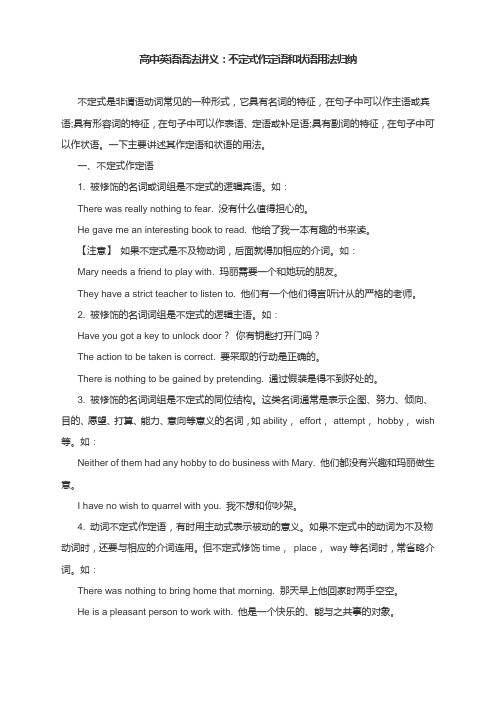
高中英语语法讲义:不定式作定语和状语用法归纳不定式是非谓语动词常见的一种形式,它具有名词的特征,在句子中可以作主语或宾语;具有形容词的特征,在句子中可以作表语、定语或补足语;具有副词的特征,在句子中可以作状语。
一下主要讲述其作定语和状语的用法。
一、不定式作定语1. 被修饰的名词或词组是不定式的逻辑宾语。
如:There was really nothing to fear. 没有什么值得担心的。
He gave me an interesting book to read. 他给了我一本有趣的书来读。
【注意】如果不定式是不及物动词,后面就得加相应的介词。
如:Mary needs a friend to play with. 玛丽需要一个和她玩的朋友。
They have a strict teacher to listen to. 他们有一个他们得言听计从的严格的老师。
2. 被修饰的名词词组是不定式的逻辑主语。
如:Have you got a key to unlock door?你有钥匙打开门吗?The action to be taken is correct. 要采取的行动是正确的。
There is nothing to be gained by pretending. 通过假装是得不到好处的。
3. 被修饰的名词词组是不定式的同位结构。
这类名词通常是表示企图、努力、倾向、目的、愿望、打算、能力、意向等意义的名词,如ability,effort,attempt,hobby,wish 等。
如:Neither of them had any hobby to do business with Mary. 他们都没有兴趣和玛丽做生意。
I have no wish to quarrel with you. 我不想和你吵架。
4. 动词不定式作定语,有时用主动式表示被动的意义。
如果不定式中的动词为不及物动词时,还要与相应的介词连用。
动词不定式表目的4则
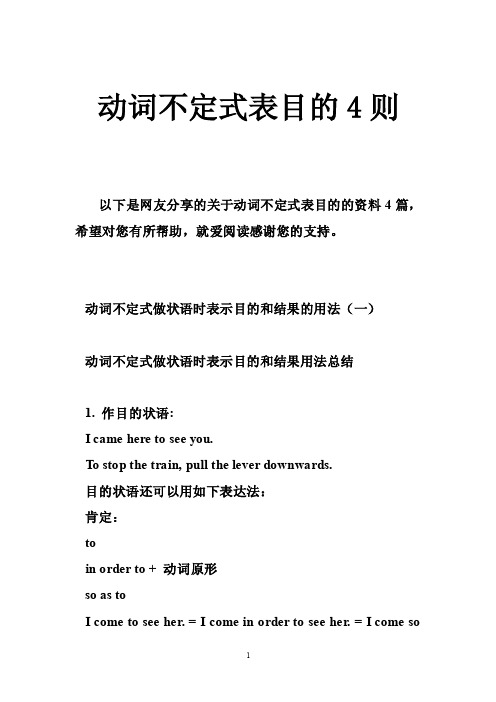
动词不定式表目的4则以下是网友分享的关于动词不定式表目的的资料4篇,希望对您有所帮助,就爱阅读感谢您的支持。
动词不定式做状语时表示目的和结果的用法(一)动词不定式做状语时表示目的和结果用法总结1. 作目的状语:I came here to see you.T o stop the train, pull the lever downwards.目的状语还可以用如下表达法:肯定:toin order to + 动词原形so as toI come to see her. = I come in order to see her. = I come soas to see her.thatso that + 主语+ may/might + 动词原形I come that I may see her. = I come in order that I may see her. = I come so that I may see her.否定:not toin order not to + 动词原形so as not tothatso that + 主语+ may/might ++ 动词原形in order thatHe went away not to see me.= He went away in order not to see me.= He went away so as not to see me.= He went away in order that he might not see me.= He went away that he might not see me.= He went away so that he might not see me.in order to, in order that和so as to, so that的区别in order to可以用在句首或句末,但so as to只能用在句末。
不定式作状语的用法总结

不定式作状语的用法总结以下是小编为大家整理的不定式作状语的用法总结,希望能帮助大家更好地认识不定式,提高英语水平1) 表原因I'm glad to see you.3)作结果状语,表事先没有预料到的,要放在句子后面。
What have I said to make you angry.He searched the room only to find nothing.2)目的状语To… only to (仅仅为了), in order to, so as to, so(such)… as to… (如此……以便……)He ran so fast as to catch the first bus. 他飞快地跑以便赶上第一班车。
I come here only to say good-bye to you. 我来仅仅是向你告别。
典型例题The chair looks rather hard, but in fact it is very comfortable to ___.A. sitB. sit onC. be seatD. be sat on答案:B. 如果不定式为不及物动词,其后应有必要的介词。
当动词与介词连用时,常位于"形容词+动词不定式"结构的末尾。
--------------------------------------------------------------------------------------不定式作状语的用法总结相关文章推荐:7.12 不定式的特殊句型so as to常后接to do sth和for [of] doing sth的名词practise 的用法详解高中英语语法知识点归纳总结seem做系动词的用法讲解。
动词不定式作状语
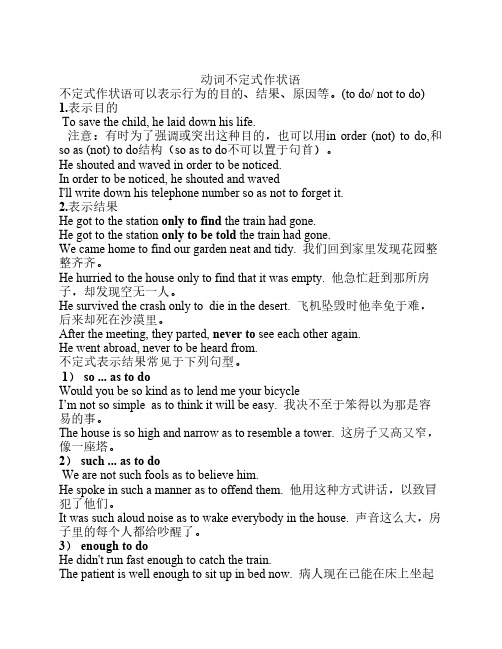
动词不定式作状语不定式作状语可以表示行为的目的、结果、原因等。
(to do/ not to do) 1.表示目的To save the child, he laid down his life.注意:有时为了强调或突出这种目的,也可以用in order (not) to do,和so as (not) to do结构(so as to do不可以置于句首)。
He shouted and waved in order to be noticed.In order to be noticed, he shouted and wavedI'll write down his telephone number so as not to forget it.2.表示结果He got to the station only to find the train had gone.He got to the station only to be told the train had gone.We came home to find our garden neat and tidy. 我们回到家里发现花园整整齐齐。
He hurried to the house only to find that it was empty. 他急忙赶到那所房子,却发现空无一人。
He survived the crash only to die in the desert. 飞机坠毁时他幸免于难,后来却死在沙漠里。
After the meeting, they parted, never to see each other again.He went abroad, never to be heard from.不定式表示结果常见于下列句型。
1) so ... as to doWould you be so kind as to lend me your bicycleI’m not so simple as to think it will be easy. 我决不至于笨得以为那是容易的事。
to do 不定式作状语

to do 不定式作状语
不定式作状语是英语中常见的非谓语动词用法,用于表达动词不定式的逻辑主语或逻辑宾语。
不定式可以作以下几种状语:
1、作目的状语
不定式可以表示行为的目的。
例如:
He got up early to catch the bus.
为了赶公共汽车,他早起得很早。
2、作原因状语
不定式可以表示原因,通常与be或feel连用。
例如:
I am sorry to hear that you are leaving.
我听说你要走了,我很难过。
3、作结果状语
不定式可以表示结果,通常与only连用。
例如:
He hurried to the airport only to find that the flight had been cancelled.他匆忙赶到机场,结果却发现航班已被取消。
4、作方式状语
不定式可以表示方式或方式状语。
例如:
To blend in with the crowd, he wore a disguise.
为了融入人群,他化了装。
5、作伴随状语
不定式可以表示伴随的动作或状态。
例如:
He stood there, thinking for a moment.他站在那里想了一会儿。
动词不定式作状语八种用法

动词不定式作状语八种用法1. 作目的状语目的状语的作用也叫作“为了达到某种目的而去做某事”,它体现了动作的目的,结构上通常由“to do”构成,“to do”可以是表示动作、状态或态度等各种类型的不定式。
例如:He stoped working in order to rest. 他停下了工作以便休息。
原因状语的作用也叫作“由于某种原因而去做某事”,它也是动作的目的,由“because of, for, due to”等词引导,“because of, for, due to”后面接的还可以是动名词或动词不定式。
例如:条件状语的作用也叫作“如果……就……”,即以“if”引导,“if”之后跟随的可以是动名词或动词不定式。
例如:If I were you, I wouldn't go there. 如果我是你,我就不去那里了。
As soon as he got into the classroom,he started writing on the blackboard. 他一进教室就开始在黑板上写东西了。
让步状语的作用也叫作“尽管……也……”,也叫作“notwithstanding”,表示对某种情况的认可与接受,以“although, though, even though, no matter how”引导,“although, though, even though, no matter how” 后面接的是名词或动词不定式。
例如:6. 作结果状语结果状语的作用也叫作“以致……”,以“so”,“so…that”,“such…that”引导,“so”,“so…that”,“such…that”后面有时可接动名词,有时也可接动词不定式。
例如:The result was so bad that he had to quit. 结果如此糟糕以致他不得不辞职。
He went inside with singing. 他唱着歌走进去了。
动词不定式作结果状语的用法

动词不定式作结果状语的用法动词不定式是一种特殊形式的动词,经常被用作结果状语来表达某个动作或状态的结果。
动词不定式作结果状语时,通常放在句子的末尾,起到修饰动词、形容词或副词的作用。
以下是一些常见的用法和句型结构:1. 修饰动词动词不定式可以修饰另一个动词,表示前一个动作的目的或结果。
例如:- I went to the store to buy some groceries.(我去商店买些杂货。
)- He practices every day to improve his English.(他每天练以提高他的英语水平。
)2. 修饰形容词动词不定式可以修饰形容词,表示形容词所描述的状态或程度。
例如:- She was too tired to continue working.(她太累了,无法继续工作。
)- The exercise was too difficult for me to solve.(这道练对我来说太难了。
)3. 修饰副词动词不定式可以修饰副词,表示副词所描述的方式或程度。
例如:- He spoke loudly to be heard by everyone.(他大声说话,为了让每个人都能听到。
)- She ran quickly to catch the bus.(她快速跑去赶公交车。
)4. 特殊结构除了以上常见的用法,动词不定式还可以有其他特殊的句型结构。
例如:- so + 形容词/副词 + as to 不定式:表示结果如此程度以至于无法想象。
- The story was so interesting as to keep me up all night.(这个故事非常有趣,以至于让我整晚都无法入睡。
)- enough + 不定式:表示足够做某事。
- She is old enough to drive a car.(她已经够大了,可以开车了。
)动词不定式作结果状语的用法灵活多样,根据具体的语境和句子结构来选择合适的使用方式。
不定式作状语表示目的,结果,原因等

不定式作状语表示目的,结果,原因等不定式常可用作状语,表示:1.目的:He went out to buy a paper.他出去买报纸去了。
We’ve come to learn from you.我们是来向你学习的。
They’re working hard to fulfill the plan.他们在努力完成计划。
To succeed,we must make good preparation.要取得成功必须做好准备。
2.结果:What have I said to make you so angry?我说了什么话使你这样生气?He left,never to return.他走了再也没回来。
She lived to be ninety.她活到了九十岁。
The curtain parted,to reveal a market scene.幕开了,露出了集市场景。
3.原因:I am sorry of hear it.听了这我很难过。
She was surprised to see him.看到他她很吃惊。
We are proud be young people of China.作为中国青年我们感到自豪。
They jumped for joy to hear the news.听到这消息他们高兴得跳了起来。
4.在某方面等:She is always ready to help others.她总是乐于帮助人。
We were eager to take part in the work.我们都亟于参加这项工作。
Be careful not to catch cold.当心别感冒。
The girl is easy to get along with.这姑娘很容易相处。
不定式还可在某些句型中使用:She was too young to understand that.她年纪太小不能理解这个。
We had enough food to last a week.我们有足够的食物维持一礼拜。
动词不定式6种用法总结
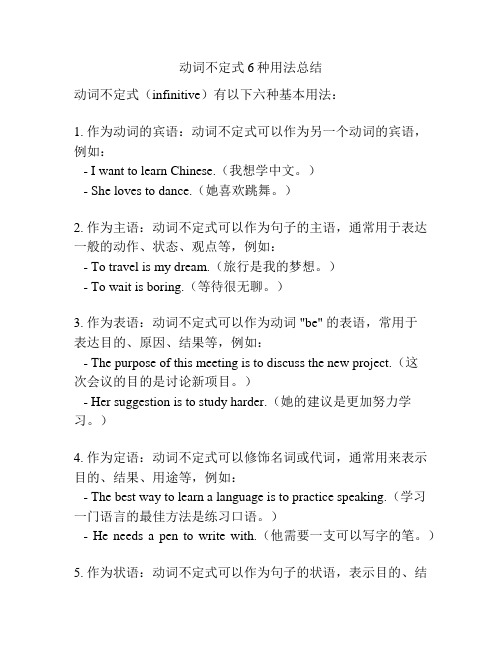
动词不定式6种用法总结动词不定式(infinitive)有以下六种基本用法:1. 作为动词的宾语:动词不定式可以作为另一个动词的宾语,例如:- I want to learn Chinese.(我想学中文。
)- She loves to dance.(她喜欢跳舞。
)2. 作为主语:动词不定式可以作为句子的主语,通常用于表达一般的动作、状态、观点等,例如:- To travel is my dream.(旅行是我的梦想。
)- To wait is boring.(等待很无聊。
)3. 作为表语:动词不定式可以作为动词 "be" 的表语,常用于表达目的、原因、结果等,例如:- The purpose of this meeting is to discuss the new project.(这次会议的目的是讨论新项目。
)- Her suggestion is to study harder.(她的建议是更加努力学习。
)4. 作为定语:动词不定式可以修饰名词或代词,通常用来表示目的、结果、用途等,例如:- The best way to learn a language is to practice speaking.(学习一门语言的最佳方法是练习口语。
)- He needs a pen to write with.(他需要一支可以写字的笔。
)5. 作为状语:动词不定式可以作为句子的状语,表示目的、结果、方式、条件等,常常与动词 "to be" 连用,例如:- She went to the supermarket to buy some groceries.(她去超市买些食品杂货。
)- He ran fast to catch the bus.(他跑得很快,以便赶上公交车。
)6. 作为补语:动词不定式可以作为某些动词的宾语补足语,常用于表示目的、愿望、需求等,例如:- They made her promise to come back.(他们让她答应会回来。
动词不定式作原因状语的用法

动词不定式作原因状语的用法
动词不定式是一种常用的语法结构,可以用作原因状语来表达某个动作或者状态的原因。
在句子中,动词不定式通常位于句子的末尾,有时也可以放在句子的前面。
以下是动词不定式作原因状语的几种常见用法:
1. 表示目的或原因:动词不定式可以用来表达某个动作或状态的目的或原因。
例如:
- 我来这里是为了研究。
(I came here to study.)
- 为了赚钱,他每天都工作到很晚。
(He works late every day to earn money.)
2. 表示结果或影响:动词不定式可以用来表示某个动作或状态的结果或影响。
例如:
- 这个消息使他很开心。
(The news made him happy.)
3. 表示目标或期望:动词不定式可以用来表示某个动作或状态
的目标或期望。
例如:
- 我们努力研究是为了取得好成绩。
(We study hard to get good grades.)
- 她每天早上锻炼是为了保持健康。
(She exercises every morning to stay healthy.)
总结起来,动词不定式作原因状语的用法包括表示目的或原因、表示结果或影响,以及表示目标或期望。
在使用动词不定式时,需
要根据具体语境选择合适的动词和适当的时态。
注意:动词不定式作原因状语时,动词不定式通常不带“了”,
且其位置可以灵活调整,但一般放在句子的末尾。
以上是动词不定式作原因状语的用法的简要介绍。
希望对您有
所帮助!。
- 1、下载文档前请自行甄别文档内容的完整性,平台不提供额外的编辑、内容补充、找答案等附加服务。
- 2、"仅部分预览"的文档,不可在线预览部分如存在完整性等问题,可反馈申请退款(可完整预览的文档不适用该条件!)。
- 3、如文档侵犯您的权益,请联系客服反馈,我们会尽快为您处理(人工客服工作时间:9:00-18:30)。
动词不定式做状语时表示目的和结果用法总结
1.作目的状语:
I came here to see you.
To stop the train, pull the lever downwards.
目的状语还可以用如下表达法:
肯定:
to
in order to + 动词原形
so as to
I come to see her. = I come in order to see her. = I come so as to see her.
that
so that + 主语+ may/might + 动词原形
in order that
I come that I may see her. = I come in order that I may see her. = I come so that I may see her.
否定:
not to
in order not to + 动词原形
so as not to
that
so that + 主语+ may/might + not + 动词原形
in order that
He went away not to see me.
= He went away in order not to see me.
= He went away so as not to see me.
= He went away in order that he might not see me.
= He went away that he might not see me.
= He went away so that he might not see me.
in order to, in order that和so as to, so that的区别
in order to可以用在句首或句末,但so as to只能用在句末。
如:
He got up very early in order to/so as to catch the first bus.
In order to catch the first bus, he got up very early.(此时不能用so as to)
so as to 和in order to的汉语意思应该是一样的“为的是,为了”。
它们的英语功能也是一样的,都可以用来引导目的状语。
它们的不同之处就在于so as to 不能用于句子的开头,在句子开头只能用in order to.
另外,
1.in order to 一般用in order that加从句来替换;而so as to 一般用so that加从句来替换。
in order that 可
以在句首,so that和so as to 一样不能在句首。
2.当这两个短语后的不定式动词的逻辑主语和句子的主语一致时,“in order to , so as to +不定式”可以简化
为“不定式”
In order to get to school on time, he got up earlier.这个句子可以表达为下列几种方式:
In order that he could get to school on time, he got up earlier.
He got up earlier in order to get to school on time.
He got up earlier in order that he could get to school on time.
He got up earlier so as to get to school on time.
He got up earlier so that he could get to school on time.
To get to school on time, he got up earlier. (这种不定式有时可以表示目的以外的状语)
注意:不定式本身有自己的主语时,可用“for…to”来表示。
如:
My father bought a new book for me to read.
2.作结果状语:
He hurried to the school to find nobody there.
What have I done to offend you?
结果状语还可以用如下表达法:
adj as to + 动词原形
so + + (表示正面的结果,解释为“如此...以至于”) adv that + 主语+ can/could + 动词原形
adj
= + enough to + 动词原形(表示正面的结果,解释为“如此...以至于”)
adv
He studied so hard as to pass the examination.
= He studied so hard that he could pass the examination.
= He studied hard enough to pass the examination
注意:enough与形容词或副词连用时,要置于形容词或副词之后。
The water is warm enough for us to swim.
I wish you’d write clearly enough for us to read it.
enough可置于名词前做修饰语,在正式语体中有时可以放在名词后。
Have you got enough room/room enough to seat all of us?
adj adj
too + + to …= so + + that + 主语+cannot + 动词原形
adv adv
adj
= not + + enough to + 动词原形(表示反面的结果,解释为“太...以至不能”)
adv
You are too young to learn to drive.
= You are so young that you can’t learn to drive.
= You are not old enough to learn to drive.
such as to ... 和such...as to及such that…和such…that…的区别
1. such 有两种词性:名词性的不定代词和形容词。
正是由于词性不同,所以在表示“如此...以致于” 这种意思时就出现了两种不同的结构。
such as to ... 中的such 属于不定代词,指代上文提到过的人或事物,意思是“这样的人/如此的事物”,如:The case has been such as to prove true. 情况已经如此,以致于证明是真实的。
Their anxiety was such as for them not to be able to sleep. 他们如此焦虑,以致于难以入睡。
2. such ... as to ... 中的such 属于形容词,需要放在名词前作定语,意思是“这样的/如此的...”,如:
We are not such fools as to believe him. 我们不是那样的蠢人, 以致于能够相信他。
She had such a fright as to faint. 她如此吃惊以致于吓得昏了过去。
Such as to 和such...as to 中,如果把不定式加上主语改为结果状语从句,就变成了such that ... 和such ... that ...。
以下就是上面句子改写成的从句:
The case has been such that it can prove true. 情况已经如此,以致于(情况)证明是真实的。
Their anxiety was such that they could not sleep. 他们如此焦虑,以致于(他们)难以入睡。
We are not such fools that we can believe him. 我们不是那样的蠢人, 以致于(我们)能够相信他。
She had such a fright that she fainted. 她如此吃惊以致于(她)吓得昏了过去。
表示令人意外的结果用only + to find / discover / realize
He lifted a rock only to drop it on his own feet.
They queued for hours at the box office only to discover that the show was sold out.。
